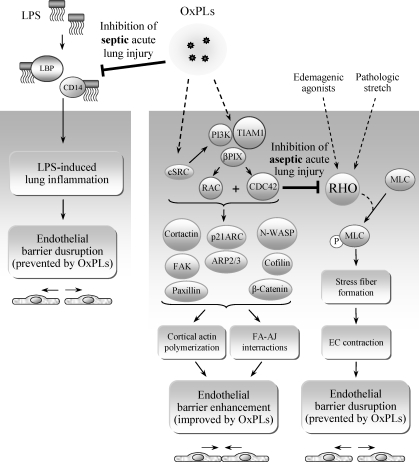FIG. 15.
Protective effects of OxPLs against acute lung injury and endothelial barrier dysfunction. PL oxidation products such as OxPAPC can inhibit lung damage in acute bacterial inflammation due to their ability to inhibit activation of TLRs 2 and 4. Furthermore, PL-esterified isoprostanes activate tyrosine kinase SRC and PI3K-AKT signaling, leading to recruitment of RAC/CDC42 specific nucleotide exchange factors TIAM1 and βPIX, stimulation of RAC and CDC42 GTPases and their effectors involved in activation of peripheral actin polymerization (cortactin, p21ARC, ARP2/3, N-WASP, cofilin), focal adhesion remodeling (FAK, paxillin) and enhancement of adherens junctions (β-catenin). These cytoskeletal changes are critical for enhancement of vascular endothelial barrier properties. Finally, OxPAPC and other classes of OxPLs protect against vascular hyperpermeability caused by edemagenic, inflammatory factors, and pathologic lung overdistension. This protection involves inhibition of RHO GTPase-dependent pathway of endothelial contraction and monolayer barrier disruption via activation of RAC-dependent mechanisms triggered by OxPLs.

